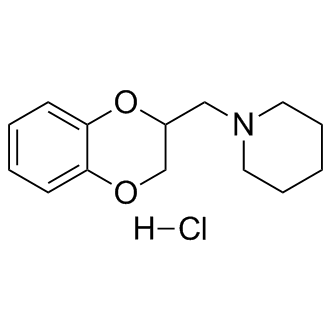| Cas No.: | 135-87-5 |
| Chemical Name: | Piperoxan HCl |
| Synonyms: | Piperoxan HCl; F 933 hydrochloride; F933; F-933; F 933; Piperoxane hydrochloride; benodaine |
| SMILES: | [NH+]1(CC2OC3=CC=CC=C3OC2)CCCCC1.[Cl-] |
| Formula: | C14H20ClNO2 |
| M.Wt: | 269.769 |
| Purity: | >98% |
| Sotrage: | 2 years -20°C Powder, 2 weeks 4°C in DMSO, 6 months -80°C in DMSO |
| Description: | Piperoxan hydrochloride is an α2 adrenoceptor antagonist. |
| Target: | adrenoceptor[1] |
| In Vitro: | When the medulla is superfused with α2 adrenoceptor antagonist Piperoxane (50 μM; 5 min) while the pons is with artificial cerebrospinal fluid (ACSF), the three inactive preparations display rhythmic phrenic bursts at a low frequency (2-4 c/min), and the phrenic burst frequency of the 12 active ones significantly increases during the last 3 min of Piperoxane applications (163±12% of the previous mean frequency). In active medullary preparations, the effects of NA applications (25 μM; 5 min) are compared when the preparations sre superfused either by ACSF (n=8) or by the α2 adrenoceptor antagonist Piperoxane (50 μM; PIP-ACSF; n=5). NA applications either alone (NA-ACSF) or with Piperoxane (PIP-ACSF+NA) significantly increases the phrenic burst frequency. However, the blockage of the medullary α2 adrenoceptors by Piperoxane potentiates a phrenic burst frequency increase: during the fifth minute of NA applications, the phrenic burst frequency reached 171±11% of the mean control value when ACSF is applied alone and 234±21% of the mean control value when PIP-ACSF is applied in control condition[1]. |
| Kinase Assay: | The mouse neonates (P0-P3) are ether-anesthetized and decerebrated; the brain stems and the cervical spinal cords are dissected out and placed ventral sides up in a 2 mL chamber superfused with artificial cerebrospinal fluid (ACSF) at 27±0.25°C (mean±SD), renewed at a rate of 2 mL/min. The ACSF [containing (in mM) 129 NaCl, 3.35 KCl, 1.26 CaCl2, 1.15 MgCl2, 21 NaHCO3, 0.58 NaH2PO4, and 30 glucose] is oxygenated and equilibrated (pH 7.4 at 27°C) by bubbling carbogene (95% O2-5% CO2). In the pharmacological experiments, this is replaced by another ACSF in which bioreactive substances are dissolved: noradrenaline at 25 μM (NA-ACSF) or α2 adrenoceptor antagonists, either Piperoxane at 50 μM (PIP-ACSF) or yohimbine at 50 μM (YO-ACSF). In some of the experiments, a patch-clamp microelectrode (1 μm diameter tip) is lowered within the ventral pons into the A5 nucleus where a solution of either ACSF or NA (1 mM) is pressure-ejected. The ejected volume is estimated 20 nL for a pressure pulse lasting 2 s[1]. |
| Animal Administration: | Mice[2] Male Balb-C mice are used, weighing between 20 and 25 g. In mice pretreated with the α-adrenoceptor antagonist Piperoxan, or with naloxone, both at a dose of 3×10-5 mol /kg s.c. given 15 min before the acetic acid, the antinociceptive action of (-)-isoprenaline is only slightly antagonized. Dose-ratios of 1.45 and 1.7, are produced by these two antagonists. |
| References: | [1]. Viemari JC, et al. Nasal trigeminal inputs release the A5 inhibition received by the respiratory rhythm generator of the mouse neonate. J Neurophysiol. 2004 Feb;91(2):746-58. [2]. Bentley GA, et al. The antinociceptive action of some beta-adrenoceptor agonists in mice. Br J Pharmacol. 1986 Jul;88(3):515-21. |

 DC Chemicals' products qualify for U.S. tariff exemptions. We guarantee no price increases due to customs duties and maintain stable supply, continuing to deliver reliable research solutions to our American clients.
DC Chemicals' products qualify for U.S. tariff exemptions. We guarantee no price increases due to customs duties and maintain stable supply, continuing to deliver reliable research solutions to our American clients.





















